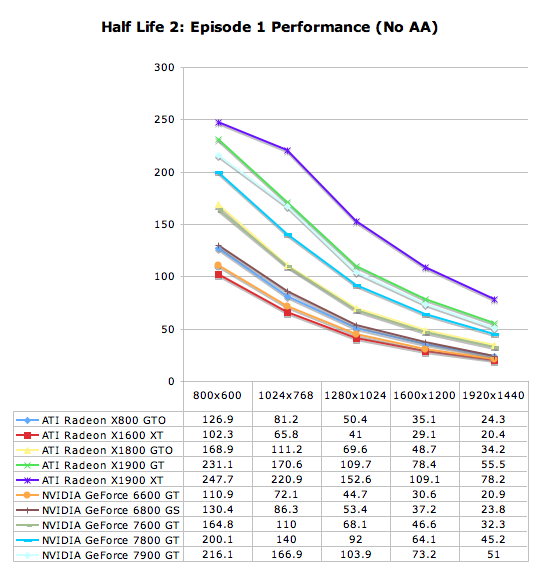Half-Life 2: Episode One Performance
Episode One of the new Half-Life 2 series makes use of recent Source engine updates to include Valve's HDR technology. While some people have done HDR that won't allow antialiasing (even on ATI cards), Valve put a high value on building an HDR implementation that everyone can use with whatever settings they want. Consistency of experience is usually not important enough to developers who care about pushing the bleeding edge of technology, so we are very happy to see Valve going down this path.
We use the built-in timedemo feature to benchmark the game. Our timedemo consists of a protracted rocket launcher fight and features much debris and pyrotechnics. The source engine timedemo feature is more like the nettimedemo of Id's Doom 3 engine, in that it plays back more than just the graphics. In fact, Valve includes some fairly intensive diagnostic tools that will reveal almost everything about every object in a scene. We haven't found a good use for this in the context of reviewing computer hardware, but our options are always open.
The highest visual quality settings possible were used including the "reflect all" setting which is normally not enabled by default. Antialiasing was left disabled for this test, and anisotropic filtering was set at 8x. While the Source engine is notorious for giving great framerates for almost any hardware setup, we find the game isn't as enjoyable if it isn't running at at least 30fps. This is very attainable even at the highest resolution we tested on most cards, and thus our target framerate is a little higher in this game than others.

All current generation midrange cards except the X1600 XT are capable of running Half-Life 2: Episode One with all the eye candy enabled at 1920x1440. This is good news for people with the upper end of large affordable wide format display panels who like to play Half-Life 2 based games. Those with the older generation cards (or displays that max out at a lower resolution) may need to run at a lower resolution in order to enjoy their HL2:Ep1 experience.

Looking at lower resolutions, the X1900 XT is running into a CPU bound situation at 800x600 with the Core 2 Extreme, but at 250fps we don't really feel the loss that hard. Every card we tested is essentially playable at 1600x1200 under this game, but those with cards on the lower end of the spectrum may prefer to drop resolution a little more and use the reflect world rather than reflect all setting to avoid hiccups. The X1900 GT is the most bang for the buck solution once again, though we'll have to reserve some judgement for the overclocked 7900 GT when we take a look at it. Not even Valve's traditionally ATI friendly engine can make the X1600 XT look like a good buy though.










74 Comments
View All Comments
rcc - Monday, August 14, 2006 - link
For my past sins I did a brief stint at Fry's Electronics. Only 5% of customers send in rebates and follow up. The stores count on this.So, I think I'd ignore them too. Unless just to note that rebates may be available on some items, but that pretty much applies to anything at any time.
Josh7289 - Thursday, August 10, 2006 - link
On Page 5, Black and White 2 Performance, this is written:Obviously, "6800 GT" should be "6800 GS". ;)
DerekWilson - Thursday, August 10, 2006 - link
Obviously :-)Nelsieus - Thursday, August 10, 2006 - link
It was probably really hard making final conclusions as you noted (with price cuts and factory OCs, etc), but I think overall, you came up with some excellent choices. The review was very fair and balanced, indepth, and overall covered all the basis.Another great article, Derek. Thanks for keeping an eye out for us midrange buyers. :)
saiku - Thursday, August 10, 2006 - link
amen, thanks for remembering the guys in the "middle".DerekWilson - Thursday, August 10, 2006 - link
Thanks! We did want to do even more with it, but we were afraid if we worked any longer on it we'd have to deal with another price cut before it got published :-)Josh7289 - Thursday, August 10, 2006 - link
I have a question. When looking at performance for games at 1600x1200 no AA, could I compare that to what I would get with 1280x1024 with AA on? Thanks.Gigahertz19 - Thursday, August 10, 2006 - link
You overclock the 7900 GT and it gets a great boost in performance. I would like to know how well the X1900 XT overclocks?I think you should have overclocked the Top Midrange ATI X1900 XT and see how well it could outperfrom an overclocked 7900GT or a stock 7900 GTX....
or maybe compared an overclocked 7900 GT to a stock clock 7900 GTX then compare an overclocked ATI X1900 XT to a stock clock ATI X1900 XTX.
Nice article by the way, this comes at a perfect time when I'm about to build a new computer in a few weeks. Going to wait until September until Nvidia 590 chipsets for Conroe and see what else comes out by that time then buy :)
DerekWilson - Thursday, August 10, 2006 - link
There are no factory overclocked X1900 XT cards for sale. The clock speed difference between the X1900 XT and the X1900 XTX essentially means that an overclocked X1900 XT would *be* an X1900 XTX.We tested the NVIDIA cards at higher clock speeds because they are sold at higher clock speeds. We weren't trying to snub ATI; it's just that people can actually get this performance out of the box.
yacoub - Thursday, August 10, 2006 - link
Top of the Final Words page, first sentence:While this has been quite a lot of information to absorb, but we will do our best to sort it all out.
Remove the "While" and capitalize the 't' in "this", or remove "but". =)